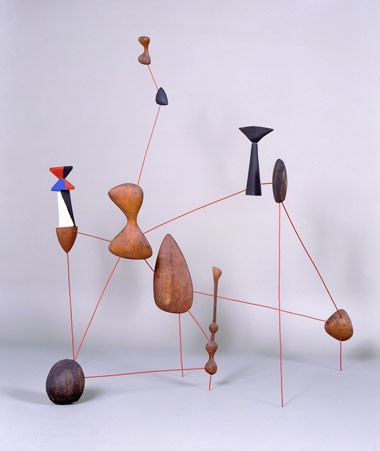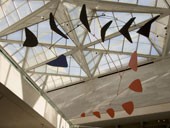In Art What Are the Different Forms of Shape
The Elements of Art: Course
Grade Level: iii–4
Students will be introduced to 1 of the basic elements of art—form—by analyzing the types of forms and materials used in diverse sculptures. Students volition and so experiment with line in both ii and three dimensions to run across how shapes become forms.

Alexander Calder
American, 1898–1976
Vertical Constellation with Bomb, 1943
painted steel wire, painted woods, and forest, 77.five x 75.6 10 61 cm (xxx 1/2 x 29 3/4 x 24 in.)
National Gallery of Fine art, Gift of Mr. and Mrs. Klaus G. Perls
© 2000 Manor of Alexander Calder / Artists Rights Society (ARS), New York
Curriculum Connections
- Math (geometry)
Materials
- Smart Lath or reckoner with ability to project images from slideshow
- Paper
- Pencil or pen
- A single length of lightweight wire (such as plastic-coated electrical wire, copper, or brass wire from a hardware store)
- Clay or string for final presentation
- Yarn in various types
- Glue
- Objects that show different forms such as a ball, box, paperweight, etc.
Warm-up Questions
What exercise the forms on this sculpture remind yous of? Can yous find geometric shapes? Do some of the forms look like things in nature?
Background
Imagine using an air pump to inflate apartment shapes. What do you get? Form! Forms are shapes in three dimensions:
Circle —> Sphere
Foursquare —> Cube
Rectangle —> Rectangular prism
Triangle —> Pyramid
These are geometric forms, which are precise and regular. Accept students feel the forms of various objects that are spheres, cubes, and pyramids. They are ofttimes found in human-made things, like buildings and machines while biomorphic shapes are found in nature. These shapes may look like leaves, flowers, clouds—things that grow, menstruation, and move. The term biomorphic ways: life-form (bio=life and morph= form). Biomorphic shapes are often rounded and irregular, and can as well turn into forms. Sculpture is the most obvious identify to run into grade, or three-dimensional shape, in art.
This work of art by Alexander Calder includes both geometric and biomorphic forms. His training as an engineer was important to his working method. Known for carrying a pair of pliers with him at all times, Calder'southward get-go contribution to modern sculpture was working exclusively in wire during the 1920s. Early on sculptures, which take been described as iii-dimensional drawings, were mainly portraits of friends and depictions of animals or circus characters.

An example of 1 of Calder's mobiles
Alexander Calder
American, 1898–1976
Untitled, 1976
aluminum and steel, 910.3 ten 2315.5 cm (358 3/8 x 911 v/8 in.) gross weight: 920 lb.
National Gallery of Art, Gift of the Collectors Committee
Alexander Calder invented mobiles—sculptures that moved—in the early on 1930s. During World War II, Calder created the Constellations series. The pieces are motionless, chosen stabiles, even so blusterous, like mobiles. Many, for example Vertical Constellation with Flop, rest on a flat surface, but some Constellations are mounted from the wall at an angle. Mostly, they are composed of small abstract forms carved from wood that are carefully arranged in three dimensions. The materials are either painted or left unfinished. Vertical Constellation with Bomb is one of the more complex works in the series, combining forms of varying sizes that define broader 3-dimensional space than other Constellations. On the periphery, smaller forms achieve out, suggesting movement into further horizons. There are five bare wooden forms and five painted forms, iv of which are black. The wires are painted red.
Guided Practice
View the slideshow beneath to have students draw the forms they see by answering the following questions for each sculpture:
- Are the forms geometric or biomorphic? Or both?
- What exercise you remember the sculpture is made of? Metal, stone, forest, plastic, clay, marble, or something else?
- Practise you think information technology's made out of a single slice or multiple ones? If multiple, how would you adhere them together? (If yous wait closely at Martin Puryear's Lever No. 3, you will discover seams of laminated strips of pino, which the artist planed, sanded, and painted blackness. In many places, the blank woods shows through, giving the sculpture a distinctly handmade look. Puryear is an ardent craftsperson, who studied woodworking techniques as office of his creative grooming.)
- If the work of fine art is abstract, what does the sculpture remind you of? Something man-fabricated or in nature?
Slideshow: Form in Works of Art

Alexander Calder
American, 1898–1976
Rearing Stallion, c. 1928
wire and painted woods, 57.8 10 34.iii 10 24.8 cm (22 iii/four x 13 ane/2 ten 9 3/4 in.)
National Gallery of Art, Gift of Mr. and Mrs. Klaus Grand. Perls
© 2000 Estate of Alexander Calder / Artists Rights Social club (ARS), New York
Activeness
While studying at the Art Students League in New York, Alexander Calder developed a talent for continuous line cartoon: creating an prototype with one unmarried, unbroken line. He further honed his skills equally a draftsman while working for several newspapers in New York Urban center. Calder'due south exploration of line moved into three dimensions when he began to create sculptures fabricated of wire, similar Rearing Stallion (correct), a material that he had loved since he was a boy.
Students will experiment with line in both two and 3 dimensions to see how shapes become forms:
- Students will choose a subject they can closely observe: a swain classmate, a bloom, an object in the classroom, or—like Calder—an creature.
- Before picking upwards their pencil, guide them to let their eyes wander over the edges of their subject. Alternatively, students can follow the edges of their chosen objects with their fingers to get a sense of overall course.
- Side by side, using their index finger, students should trace the outlines of the subject in the air and so on their paper. As an alternative to conform visual impairments, students would be given a mucilage bottle to draw with on paper.
- Finally, students volition apply their pencil or pen to begin to draw, working slowly without lifting the pencil until the whole flick is finished. The continuous line can cantankerous over itself and loop from one surface area to another until the single line has drawn the entire subject field. Continuous line drawings take practice, then they may need to explore different strategies by making several drawings of the aforementioned subject. As an alternative to accommodate visual impairments, students would use lengths of yarn to place over the glue outline to create a raised surface cartoon.
- At present try it in wire! Retrieve of wire as a single continuous line. Demonstrate how to advisedly bend and twist a single length of thin wire to create a 3-dimensional "drawing." Students will then recreate their line drawing in wire.
Extension
Showroom the sculptures next to the line drawings for form give-and-take. (To display the wire sculptures, they can either exist stuck into a lump of clay or be hung up with string.) Student artists should each answer the following questions about their process:
- What was challenging about making a continuous line cartoon?
- What was dissimilar about making the sculpture?
- What did you learn from trying both?
The Elements of Fine art is supported by the Robert Lehman Foundation
National Core Arts Standards
VA:Cn10.1.3 Develop a work of art based on observations of environment.
VA:Cr2.2.4When making works of art, apply and care for materials, tools, and equipment in a fashion that prevents danger to oneself and others.
VA:Re7.ane.4 Compare responses to a work of art before and subsequently working in similar media.
VA:Re8.1.three Interpret art by analyzing use of media to create subject matter, characteristics of form, and mood.
garretsontwoun1957.blogspot.com
Source: https://www.nga.gov/learn/teachers/lessons-activities/elements-of-art/form.html






0 Response to "In Art What Are the Different Forms of Shape"
Post a Comment